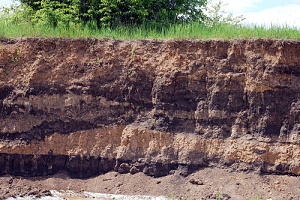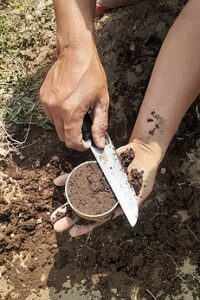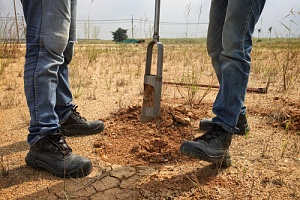Soil is one of the most basic construction materials in existence, and it forms the foundation of all manner of construction projects. Soil is often removed, filled, shaped or replaced to accommodate structures and pavements, and compacting soil can make a big difference in the structural integrity of the project.
 Soil compaction takes place when soil sustains mechanical stress and becomes densified. This occurs because soil is made up of solid particles as well as voids that are filled with air or water. Any time soil is subjected to stress, its particles will be redistributed. This causes the void volume to decrease and it results in densification. A mechanical stress can be applied with dynamic or static methods to achieve compaction, and the degree of compaction can be quantified using a measurement of the change in the soil’s dry unit weight.
Soil compaction takes place when soil sustains mechanical stress and becomes densified. This occurs because soil is made up of solid particles as well as voids that are filled with air or water. Any time soil is subjected to stress, its particles will be redistributed. This causes the void volume to decrease and it results in densification. A mechanical stress can be applied with dynamic or static methods to achieve compaction, and the degree of compaction can be quantified using a measurement of the change in the soil’s dry unit weight.
What Does The Proctor Compaction Test Measure?
Soil compaction can be useful in engineering applications because it raises the soil’s strength and bearing capacity while lowering its compressibility and permeability. It also reduces the heaving caused by freezing and thawing cycles and helps to control erosion and subsidence. This is particularly useful for structures such as earth dams, pavement supports, foundation supports and embankments.
The degree of compaction that takes place will depend on the soil’s specific properties as well as its water content and the type and amount of energy that is provided in the compaction process. Each type of soil has an optimal amount of moisture at which it can achieve maximum compression. A Proctor Compaction Test is an important test that can help to determine the maximum unit weight to which a specific type of soil can be compacted using controlled compactive force at the optimal water content.
What Does The Proctor Compaction Test Entail?
The Proctor Compaction Test is one of the most common lab tests used to measure soil compaction. It was invented in the 1930s by a California field engineer for the Bureau of Water Works and Supply named Ralph R. Proctor. It simulates the type of in-situ compaction process that is normally performed when constructing embankments and earth dams. It is detailed in the ASTM D698 and AASHTO T99 test methods.
 Because the provided energy and compaction type for a given volume of soil are standard, the test is focused on the change in a sample’s moisture content, which is used to arrive at the optimum water content.
Because the provided energy and compaction type for a given volume of soil are standard, the test is focused on the change in a sample’s moisture content, which is used to arrive at the optimum water content.
The original test uses a 0.95-liter cylindrical mold. Soil mass is placed inside the mold and then compacted into three layers. Each of these layers is compressed by dropping a 2.5-kilogram weight from height of 30 centimeters onto it 25 times.
After World War II, a modified version of the Proctor test was introduced that took advantage of the higher compaction provided by the heavier machinery of the time. It uses the same cylindrical mold as the original approach, but the drop weight rises to 4.5 kilograms and the dropping height is 45 centimeters. Five layers of soil compaction are used at 25 blows per layer.
The test is carried out at five different moisture contents to reach the optimum water content. At this value, the dry unit weight is maximized.
Equipment Needed To Carry Out The Proctor Compaction Test
The equipment used for carrying out this test includes:
- A cylindrical compaction mold measuring 10 centimeters in diameter with a base and collar
- A Proctor rammer that weighs 2.5 kilograms for the standard test, or 4.5 kilograms if the modified test is being used
- A steel straightedge
- A graduated cylinder
- A mixer
- Moisture containers
- A #4 sieve
- A metallic tray
- A scoop
- A controlled oven
Proctor Compaction Test Procedure
First, it is necessary to obtain around 3 kilograms of soil and pass it through the #4 sieve. The soil mass and the mold without the collar should be weighed. This measurement is known as Wm.
Next, the soil should be placed in the mixer and water should be added to it gradually until the desired moisture content is reached. This figure is known as W.
Next, lubricant is applied to the collar and the soil must be removed from the mixer. It is then placed in the mold in three layers if the standard Proctor test is being used, or five layers if the modified Proctor test is being used. Each layer should undergo the compaction process using 25 blows. The drops may be applied either mechanically or manually, and this must be done at a steady rate. The soil mass should fill the mold and go up into the collar by no more than one centimeter.
Then, the collar should be removed carefully and any soil that extends above the mold needs to be trimmed with a sharpened straightedge. Then, the mold and the soil within it should be measured to get figure W.
 Finally, the soil should be extruded from the mold with a metallic extruder insert, ensuring that the extruder and the mold are kept in line. The water content at the top, middle and bottom of this sample should be measured. Then the soil is placed in the mixture again and water is added to achieve a higher water content, W.
Finally, the soil should be extruded from the mold with a metallic extruder insert, ensuring that the extruder and the mold are kept in line. The water content at the top, middle and bottom of this sample should be measured. Then the soil is placed in the mixture again and water is added to achieve a higher water content, W.
The compaction water content of the soil sample is determined by averaging the three measurements that were obtained from the top, middle and bottom parts of the soil mass. This is carried out using a standard formula, and the procedure is repeated four more times using selected points.
The results are then plotted on a graph showing dry unit weight versus moisture content to illustrate the curvilinear relationship and establish the optimum moisture and maximum dry weight for each type of soil.
Reach Out To The Virginia Topsoil Professionals
Working with soil can be incredibly complex. The experienced professionals at Dirt Connections are happy to help with all of your questions and concerns. We offer all manner of fill dirt, topsoil and bio mix soils in Northern Virginia and the surrounding counties and can offer advice on your construction projects. Get in touch with us today!
Summary

Dirt Connections was started with one goal in mind: providing quality residential and commercial construction services to clients on time and on budget. Reach out for more information on how we can support your next project.
For your convenience our estimates are free and by appointment. Call 703-940-9949 for a free estimate today!










































